Related Research Articles

Poultry are domesticated birds kept by humans for the purpose of harvesting useful animal products such as meat, eggs or feathers. The practice of raising poultry is known as poultry farming. These birds are most typically members of the superorder Galloanserae (fowl), especially the order Galliformes. The term also includes waterfowls of the family Anatidae and other flying birds that are kept and killed for their meat such as the young pigeons, but does not include wild birds hunted for food known as game or quarry.

Duck is the common name for numerous species of waterfowl in the family Anatidae. Ducks are generally smaller and shorter-necked than swans and geese, which are members of the same family. Divided among several subfamilies, they are a form taxon; they do not represent a monophyletic group, since swans and geese are not considered ducks. Ducks are mostly aquatic birds, and may be found in both fresh water and sea water.

The American Game is an American breed of game fowl, chickens bred specifically for cockfighting. It has many color varieties, and may also be kept for ornament.
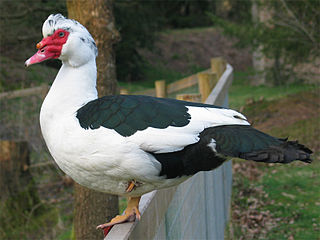
The Muscovy duck is a duck native to the Americas, from the Rio Grande Valley of Texas and Mexico south to Argentina and Uruguay. Feral Muscovy ducks are found in New Zealand, Australia, and in Central and Eastern Europe. Small wild and feral breeding populations have also established themselves in the United States, particularly in Florida, Louisiana, Massachusetts, the Big Island of Hawaii, as well as in many other parts of North America, including southern Canada.

The Pekin or White Pekin is an American breed of domestic duck, raised primarily for meat. It derives from birds brought to the United States from China in the nineteenth century, and is now bred in many parts of the world. It is often known as the American Pekin to distinguish it from the German Pekin, a distinct and separate breed which derives from the same Chinese stock but has different breeding. Many of these ducks were reared on Long Island, New York, in the late nineteenth and early twentieth centuries, from which the breed derived its name Long Island Duck.

Indian Runners are a breed of Anas platyrhynchos domesticus, the domestic duck. They stand erect like penguins and, rather than waddling, they run. The females usually lay about 300 to 350 eggs a year or more, depending whether they are from exhibition or utility strains. They were bred on the Indonesian islands of Lombok, Java and Bali where they were 'walked' to market and sold as egg-layers or for meat. These ducks do not fly and only rarely form nests and incubate their own eggs. They run or walk, often dropping their eggs wherever they happen to be. Duck-breeders need to house their birds overnight or be vigilant in picking up the eggs to prevent them from being taken by other animals.

The Campbell is a British breed of domestic duck. It was developed at Uley, in Gloucestershire, England, at the turn of the 20th century; being introduced to the public in 1898 and the Khaki variety in 1901.
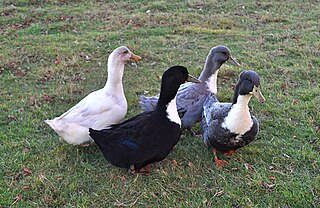
The Swedish Blue or Blue Swedish is a Swedish breed of domestic duck. It originated in the former dominion of Swedish Pomerania – now in north-west Poland and north-east Germany – and is documented there from 1835. It is closely similar to the Pomeranian Duck from the same general area, differing mainly in its white primary feathers.
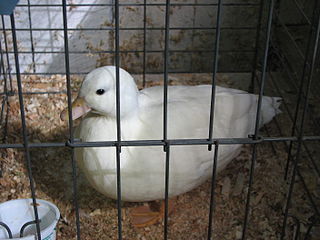
The Call is a historic breed of small domestic duck. It is believed to have originated in the Netherlands, where the earliest descriptions and depictions of it date from the seventeenth century. It is similar in appearance to some other breeds of ducks, but is much smaller, with a round head and very short bill. Female Ducks, but not drakes, are very loquacious and noisy, with a piercing high-pitched call which can be heard from far away.

The Orpington or Buff Orpington Duck is a breed of domestic duck. It is a dual-purpose breed used for meat and egg production. It is capable of laying up to 220 eggs a year. Originally created by William Cook of Orpington, Kent, England, from the selection of mis-marked Blue Orpington Ducks; Cook was also the developer of the Orpington chicken. The breeds used in the development of the breed included Cayuga, Indian Runner, commercial Aylesbury and Rouen. It is proposed that Cook's intentions for the breed were to capitalize on the growing demand for the buff colour pattern. The Buff Orpington Duck was introduced to the public at the Dairy Show, the Agricultural Hall (q.v.), Islington, London in October 1897. It is considered a threatened breed by the ALBC. This breed was admitted to the British Poultry Standard in 1910 and the American Poultry Associations Standard of Perfection as the 'Buff Duck' in the Medium class in 1914. The Orpington duck is available in three colour varieties: Buff, Blond and Brown. The Buff Orpington is an unstable colour due to a blue dilution gene which means that from the offspring, all three colour variations will appear.

The Magpie is a British breed of domestic duck. It has distinctive black and white markings reminiscent of the European magpie, and is a good layer of large eggs.
The Ixworth is an English breed of white domestic chicken. It is named for the village of Ixworth in Suffolk, where it was created in 1932. It was bred as fast-growing high-quality meat breed with reasonable laying abilities.

The Silver Appleyard is a British breed of domestic duck. It was bred in the first half of the twentieth century by Reginald Appleyard, with the aim of creating a dual-purpose breed that would provide both a good quantity of meat and plenty of eggs.
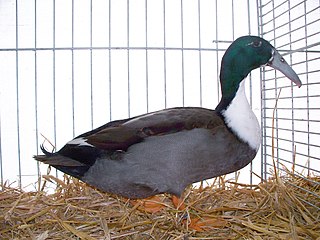
The Hook Bill or Dutch Hookbill is a breed of domestic duck characterised by an unusual down-curved beak. It is an ancient breed, and has been documented since the seventeenth century. Speculation that it originated in Asia, or is related to the Indian Runner, is apparently unsubstantiated.
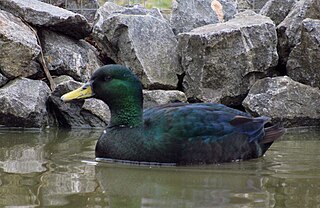
The East Indie or Black East Indian is an ornamental breed of domestic duck. It is a bantam breed, and is thought to have originated in the United States.
The Shetland duck is a breed of domestic duck originating in the Shetland Islands of Scotland. It is critically endangered.

The German Pekin, German: Deutsche Pekingente, is a European breed of domestic duck. It is commonly called simply Pekin or White Pekin. It is a different breed from the American Pekin, which is also commonly known by the same names. It was bred in Europe from birds originating in China and Japan and is distributed in many European countries.

The Blekinge duck, also known as the Coast Duck, is a medium-sized Swedish breed of domestic duck prominent to the county of Blekinge.
References
- 1 2 "List of breeds documented in the Global Databank for Animal Genetic Resources" (PDF). fao.org. FAO. 2007. p. 124. Archived (PDF) from the original on 2020-06-23. Retrieved 2024-01-27.
- 1 2 "Silver Bantam Duck: Complete Breed Guide". www.raising-ducks.com. 2017-12-18. Retrieved 2024-01-27.
- 1 2 Ashton, Chris; Ashton, Mike (2008). The domestic duck (2nd ed.). Crowood Press. p. 93. ISBN 9781847970503.
- ↑ "Miniature Silver Appleyard - Wheeler Farms | Lawn Care | Day-Old Poultry | Pumpkin Patch". wheeler-farms.com. 2021-07-26. Archived from the original on 2021-07-26. Retrieved 2024-01-27.
- ↑ "Silver Bantam Duck / United Kingdom of Great Britain and Northern Ireland (Duck (domestic))". dadis-breed-datasheet-ws.firebaseapp.com. Domestic Animal Diversity Information System of the Food and Agriculture Organization of the United Nations. 2006. Retrieved 2024-01-28.